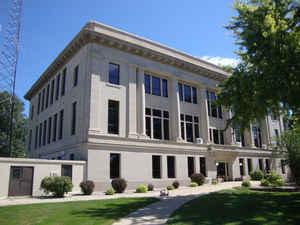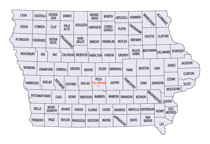Iowa Counties
There are ninety-nine counties in Iowa. The first two counties, Des Moines County and Dubuque County, were created in 1834 when Iowa was still part of the Michigan Territory. In preparation for Michigan's statehood, part of Michigan Territory was formed into Wisconsin Territory in 1836]. Two years later, the western portion was split off to become Iowa Territory. The south-eastern part of Iowa Territory became Iowa, the 29th state in the union, on 28 December 1846, by which point 44 Counties had been created. Counties continued to be created by the state government until 1857, when the last county, Humboldt County, was created.O'Brien County, Iowa
O'Brien County Education, Geography, and History
O'Brien County is a county located in the state of Iowa. Based on the 2010 census, the population was 14,398. O'Brien County was created on January 15, 1851. The county seat is Primghar. The county is named in honor of William Smith O'Brien, (1803–1864), Irish revolutionary who was inspired by American democratic ideals.
Etymology - Origin of O'Brien County Name
O'Brien county is named for William Smith O'Brien, an Irish patriot.
Demographics:
County QuickFacts: CensusBureau Quick Facts
O'Brien County History
O'Brien County is named after
William Smith O'Brien, one of the leaders of the Irish Independence in 1848.
The county was established in 1851 and originated in 1860. O'Brien County is one
of 11 counties that was carved out of Woodbury County (then called Wahkaw.) The
first courthouse in the county was built by Archibald Murray of logs cut from
the banks of the Little Sioux River. This county courthouse was rarely used as a
courthouse because of the lack of records that needed to be kept and not much
county business was conducted. This cabin was later relocated to Waterman
Township, where the county had purchased 40 acres. The first date recorded here
was on June 9, 1862.
The log cabin courthouse was replaced in 1870 by a frame building. The cost of
the building was estimated at several thousand dollars. This building was
destroyed by a fire in 1871 and replaced by a similar looking structure. In 1873
the county seat was moved to Primghar, which was more centrally located.
Primghar was named using the first letters of the first names of influential
county officials and the surveyors of the town. In 1874 a courthouse was built
on the present courthouse square. The two-story courthouse was built at a cost
of $2,000 and completed on April 4. This building was later condemned and sold
for $470.
In 1879 the citizens of Sheldon attempted to relocate the county seat to their
town. In 1882, Sanborn succeeded in removing the records from Primghar in a
"raid," but they were unsuccessful in obtaining the county seat permanently.
Following the unsuccessful attempt by Sheldon, a $6,000 courthouse was
constructed by the Green Brothers in 1887. In 1902 this building was added onto,
at a cost of $1,400.
In 1911 the city of Sheldon was again unsuccessful in obtaining the county seat.
They lost in a special election by a vote of 3,161 to 1,447.
In 1914 the voters of O'Brien County approved $160,000 towards the construction
of a new courthouse. This building was occupied in April 1917. The three-story
building is of Neo-Classical style and constructed of Bedford limestone.
Geography: Land and Water
As reported by the Census Bureau, the county has a total area of 573 square miles (1,480 km2), of which 573 square miles (1,480 km2) is land and 0.2 square miles (0.52 km2) (0.03%) is water.
O'brien county is located in northwest Iowa.
Neighboring Counties
Bordering counties are as follows:
- North: Osceola County
- Northeast: Dickinson County
- East: Clay County
- Southeast: Buena Vista County
- South: Cherokee County
- Southwest: Plymouth County
- West: Sioux County
- Northwest: Lyon County
Education







